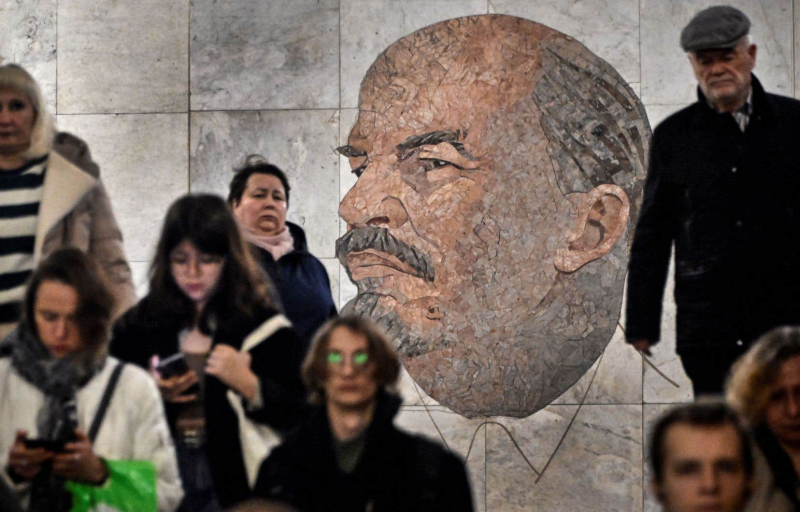
Photo: Alexander Nemenov Agence France-Presse A mosaic portrait of Vladimir Lenin, created by Soviet artist Grigory Opryshko in 1965, still stands in the Biblioteka imeni Lenina station of the Moscow Metro.
Benoit Valois-Nadeau
January 20, 2024
- Europe
Sunday will mark the hundredth anniversary of the death of Vladimir Ilyich Ulyanov, better known as Lenin, a key player in the Russian Revolution and founding father of the Union of Soviet Socialist Republics (USSR). A century later, what remains of the ambiguous memory of the creator of the first socialist state in history ?
On the afternoon of January 21, 1924, Lenin died at only 53 years old. Weakened for years by a series of strokes and confined to a wheelchair, he finally succumbed to a final attack. He leaves behind him a country bloodless following years of war (the First World War, during which he took advantage of the fall of tsarism to seize power, then the civil war which followed), but in which we are busy building the first communist economy on the planet.
In the hours that followed, his body was embalmed and placed in a glass coffin to be displayed to the public. A hundred years later, the remains of the communist leader are still in the heart of Moscow, in Red Square, where a mausoleum was built in his honor in 1930.
For any tourist staying in the Russian capital, a stop is almost obligatory. Even today, many Russians and foreigners make the detour to pay their respects and see with their own eyes the body of the man who built the first socialist state in history.
“You’d be surprised how many people go there,” says Kristy Ironside, a professor of Russian history at McGill University who has visited the mausoleum twice herself.
An experience she describes as “deeply bizarre”. “We enter the mausoleum, we go down a few steps, and then Lenin is there, illuminated in the middle of the darkness. He looks like a melted candle, he's not in great shape! » said the academic specializing in Soviet history, laughing.
This perhaps sums up Lenin's place in Russian memory: a little tarnished, but immovable.
Also read
Ideas | Lenin, the man who shook the world
Selective memory
The memory of Lenin is the object of all covetousness after his death. He then embodies the strength of the global communist movement, intelligence and self-sacrifice in the service of a cause. Stalin seized it to legitimize his accession to power. Then, Nikita Khrushchev and Mikhail Gorbachev used it to justify their reformist desires.
“After his death, Lenin was immediately recovered,” recalls Kristy Ironside. Saint Petersburg is renamed Leningrad, posters and statues of him appear everywhere, the mourning is immense. And this cult continued throughout the Soviet period. »
The cult of Lenin is attenuated, to a certain extent, by that of Stalin during the years in power of the Man of Steel. But after the death of Stalin in 1953 and the de-Stalinization process initiated by Khrushchev, it resurfaced. Same thing at the end of the 1980s, when Gorbachev began perestroika, a series of economic and social reforms to give some breathing room to the dying communist regime.
“The memory of Lenin is reactivated at this moment, but it is a very selective memory,” explains Kristy Ironside. The Lenin that Gorbachev evoked was a liberal, who would have wanted pluralism, democracy. This is far from the real Lenin, who justified the use of violence and terror several times when the Bolsheviks murdered their enemies. »
Always present
Almost 35 years after the end of the USSR, monuments in honor of Vladimir Ilyich Ulyanov can still be found almost everywhere in Russia and in some former Soviet republics, such as Belarus.< /p>
“Under Boris Yeltsin, in the 1990s, there was a lot of debate about whether to move on and get rid of Leninist symbols, but we never managed to get along and make a decision,” recalls Jean Lévesque, professor of Russian history at UQAM.
However, don't expect big celebrations on Sunday from Vladimir Putin's regime to mark the 100th anniversary of his death. It is rather on the side of the communist opposition, still tolerated by Putin and which receives up to 15% of voting intentions in certain regions, that we should anticipate any celebrations.
“The Putin government has an ambivalent relationship with the Soviet period, argues Kristy Ironside. They have inherited certain aspects of the communist system, but they are not communists. For example, the hundredth anniversary of the Russian Revolution was marked in 2017, but in very nuanced terms. We still celebrate the victory of the USSR during the Second World War, but it is seen more as a Russian victory than as a communist victory. »
The fall of communism and the end of the USSR sidelined Lenin in popular Russian imagery. But not enough for us to unbolt his statues… or to permanently put his corpse back.
“Figures from the communist years like that of Stalin were evacuated, but we never managed to get rid of Lenin,” explains Jean Lévesque. He is still there today. As if we were touching something almost sacred, almost as if it were part of the country itself. »

